


Build Community on Discord
.svg)
Build Community Articles

Server Information and Announcement Channels
Information and announcement channels are the cornerstones of making your server easy to navigate. Once you understand how to use permissions on Discord, this article will help you understand how to set up these channels, the content to include in them, and how to best present that content so that your community members can easily understand it.
Information vs. Announcement Channels
First, it’s important to know what information channels and announcement channels are. Generally speaking an information channel contains reference material provided by the server staff team about the server or its purpose. This information is usually updated infrequently throughout the servers’ life.
On the other hand, an announcement channel is generally a channel that the server staff team uses to provide updates about the server or its topic. As opposed to information channels that are rarely updated, announcement channels regularly have new messages in them. Announcement channels also have a dedicated channel type that allows other users to follow the channel and receive its messages in their own servers. You can learn more about the announcement channel type and publishing messages here.
Both kinds of channels involve restricting Send Messages permissions to trusted members only, usually the server staff team, as well as providing important information about the server or its topic. Therefore, to get the most out of your information and announcement channels, you should put them at the top of your channel list or categories and carefully consider the kinds of content to share in them.
Announcement Channel Content
Announcement channels can usually be divided into two types: announcements about your server or announcements about your topic. Whenever you make an announcement that will be relevant to those outside of your server, you can also choose to publish it and send the announcement out to those following your server. This can be a great way to inform those across Discord who may be interested in your servers’ intended purpose, but may not be interested in the latest news about your server itself.
For example, if you are a server dedicated to a specific game, you might have a #game-news announcements channel where you can post patch notes or updates to the game. To take things further, you could even use a Discord bot to let people assign and unassign a News Notification Role that can be mentioned whenever you have news to share with your server. This ensures that you only ping people who have opted into it, which is better than mentioning @everyone.
Another announcement channel you could make is a #server-announcements channel. Here, you can announce things like changes to your server, giveaways, events, and more!
In either case, announcements should be brief and contained to a single message when possible. This will also make them easier to publish, as only ten messages can be published per hour. Opening with the most important information or context as to the importance of the announcement will also encourage people to read the entire message. After explaining the announcement in detail, you can close with a brief farewell, and if applicable, invite people to discuss the announcement in relevant channels.
Example #server-announcements Message
Hello everyone, we have just opened the #original-art channel! This channel can be used to post artwork that you’ve created yourself. You can also read through the channel pins and topic for more information. If you have any questions or comments, feel free to bring them up in the #server-feedback channel. We hope you enjoy the new channel!
Example #game-news Announcements Message
@Game Updates Check out the patch notes below for the update coming next week! If you want to talk about them in detail, we encourage you to head to #game-chat to discuss the content with others. Hope you’re looking forward to it!
Information Channel Content
Content in an information channel should be useful for understanding the server or its topic. Although it is important to remain as brief as possible to ensure users read the whole channel, it’s inevitable that you may need to send the information across multiple messages and even scroll for users to see all of the content provided. Including a disclaimer at the bottom encouraging users to scroll up to the top of the channel can help users understand there is more to the channel than what is immediately visible. Pinning the top-most message of the channel can also help users quickly jump to the top and start reading.
One common type of information channel is a #rules channel where members can find a list of behavioral guidelines to follow on the server. This channel may also include a post asking people to react to a message in order to acknowledge that they have read the rules and gain access to the rest of the server. This sort of verification gate can help ensure users read your most important information channels thoroughly. With Community enabled, you can also designate the channel with your server rules as the “Rules Or Guidelines Channel,” which will give it a special icon to help it stand out. You can learn more about how to come up with rules for your community through this article.
However, it is important to remember that sometimes you may need to convey complicated information that requires several messages. To ensure that the information can still be easily understood, consider the role that formatting your messages plays in reading comprehension to avoid overwhelming text walls.
Formatting Content
When it comes to formatting, it’s important to have a basic understanding of how markdown works on Discord. This will let you appropriately bold, underline, italicize, and otherwise add basic formatting to your messages.
In addition to basic formatting, it may be necessary to break up your content into paragraphs or multiple messages to ensure people aren’t overwhelmed with a wall of text in your information channels. You can also use formatting to provide section headers, further breaking up the content into easily understandable chunks. Here’s an example showing a “community links” informational section for a game.
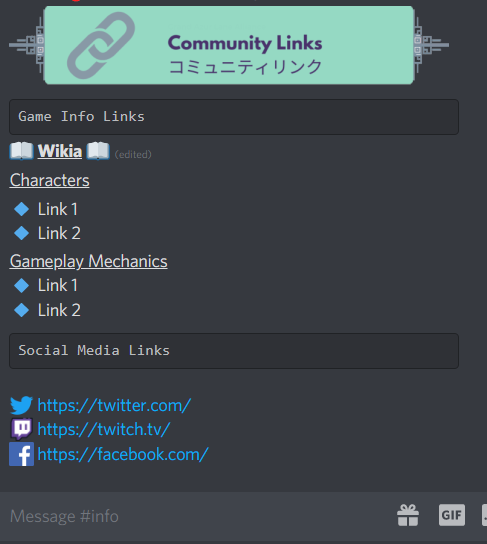
To better explain what you’re seeing in this image, we’ll explore exactly how we utilized special formatting to make this visually appealing.
- Header 1: Embedded image link. In this example, it is found in the section named “Community Links”
- It’s recommended to avoid uploading a file directly as uploaded files cannot be edited
- Header 2: Code block formatting to create section break across the screen. In this example there are two kinds of community links: “Game Info Links” and “Social Media Links”
- Header 3: Bold and Underlined text surrounded with emoji. The emoji especially provide another visual break and in this example, denote links that are all related to the game’s wikia.
- Header 4: Underlined text. This provides a less noticeable section break, using the underline effect to create a subtle horizontal rule
- Content: Use emoji to make new paragraphs or different pieces of information stand out, especially if using a bullet point format. Various shape-related default emoji, such as :small_blue_diamond: or :green_circle: are great for this. You can also use custom emoji to further label content, and with Discord Nitro you don’t even need to have those emoji on your community’s server either.
Although the first part of this example uses four levels of headers, you’ll see that the second section only uses two levels. Depending on the information you’re trying to convey, you might not need that many different sections in your information channels. This is also true for messages for announcements, as they tend to be shorter than information provided in an informational channel. However, using paragraphs and some section headers well can still help make long messages easier to read and understand.
Although information and announcement channels both provide important information to users in your server, the longevity and detail of the information in each is somewhat different. Remember that being succinct in conveying this information and providing it in an easy to understand format will help your community members better comprehend both your servers’ purpose and the community itself. Keeping this information in mind as you build your server will surely make the passing of new and important information to your community a more comfortable and efficient experience overall.

Basic Channel Setup
While managing a Discord server, you will frequently find yourself needing to create private areas of the server for specific people or for specific purposes. This is easily achievable on Discord by making use of categories, roles and permissions.
Getting Started
This article will assume that you’ve read the following guides:
To demonstrate how to utilize these tools, we’re going to build a server focused around a robotics tournament where our community members gain access to a region-specific group of channels.
We’ll break this up into a few steps:
- Creating the welcome channel where users will find information on how to get their roles.
- Create the necessary roles for our region lock.
- Create the channels for each region.
Creating a Welcome Channel
We’re going to need somewhere with information about how users can gain access to the region locked sections of the server, so we’ll start by making a #welcome channel. We’ll put some instructions in there for the future so that users in the server know how to get roles.
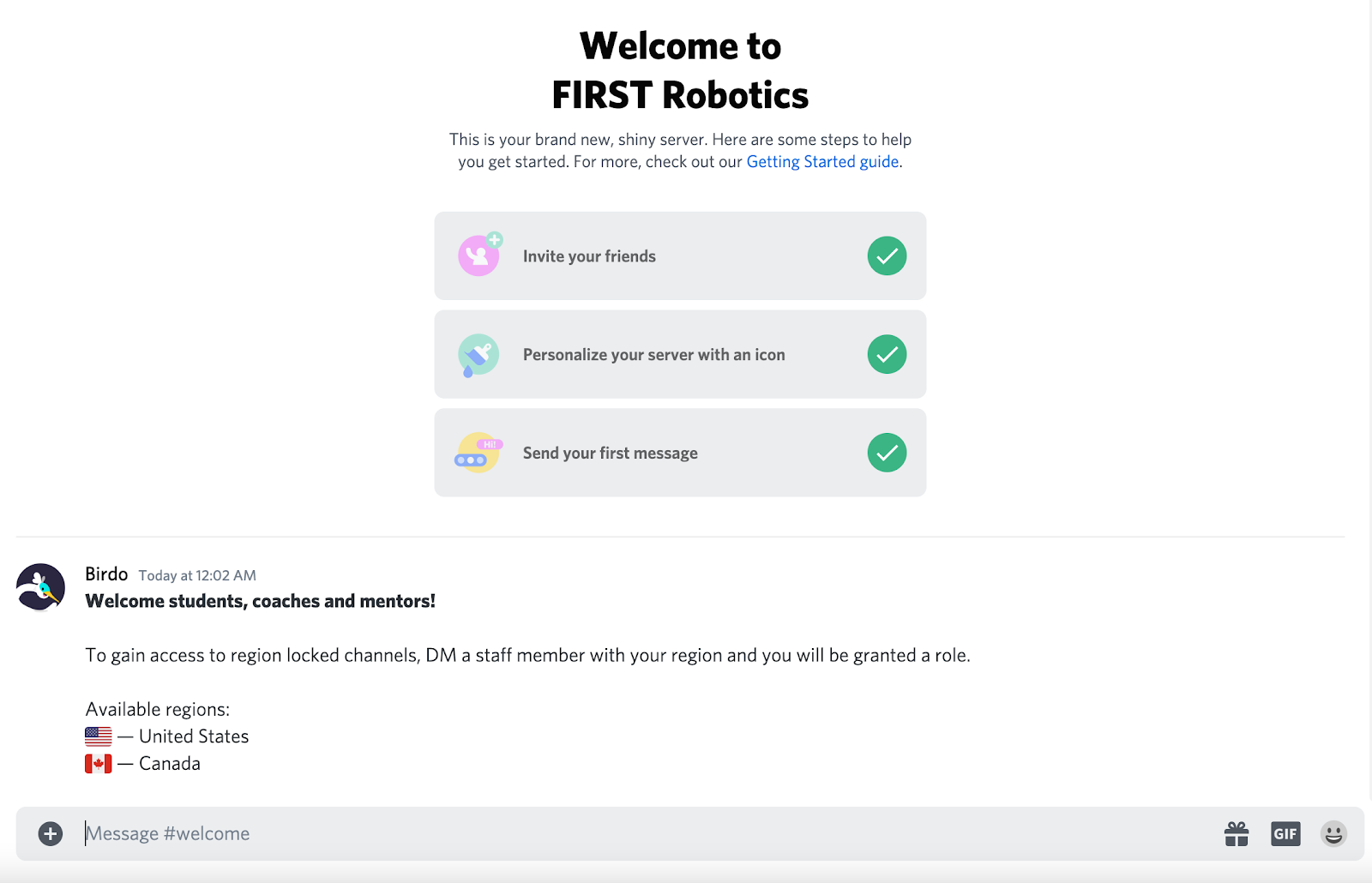
Currently, any user can send a message in our welcome channel. Let’s set up the permissions in the channel so the @everyone role cannot type.
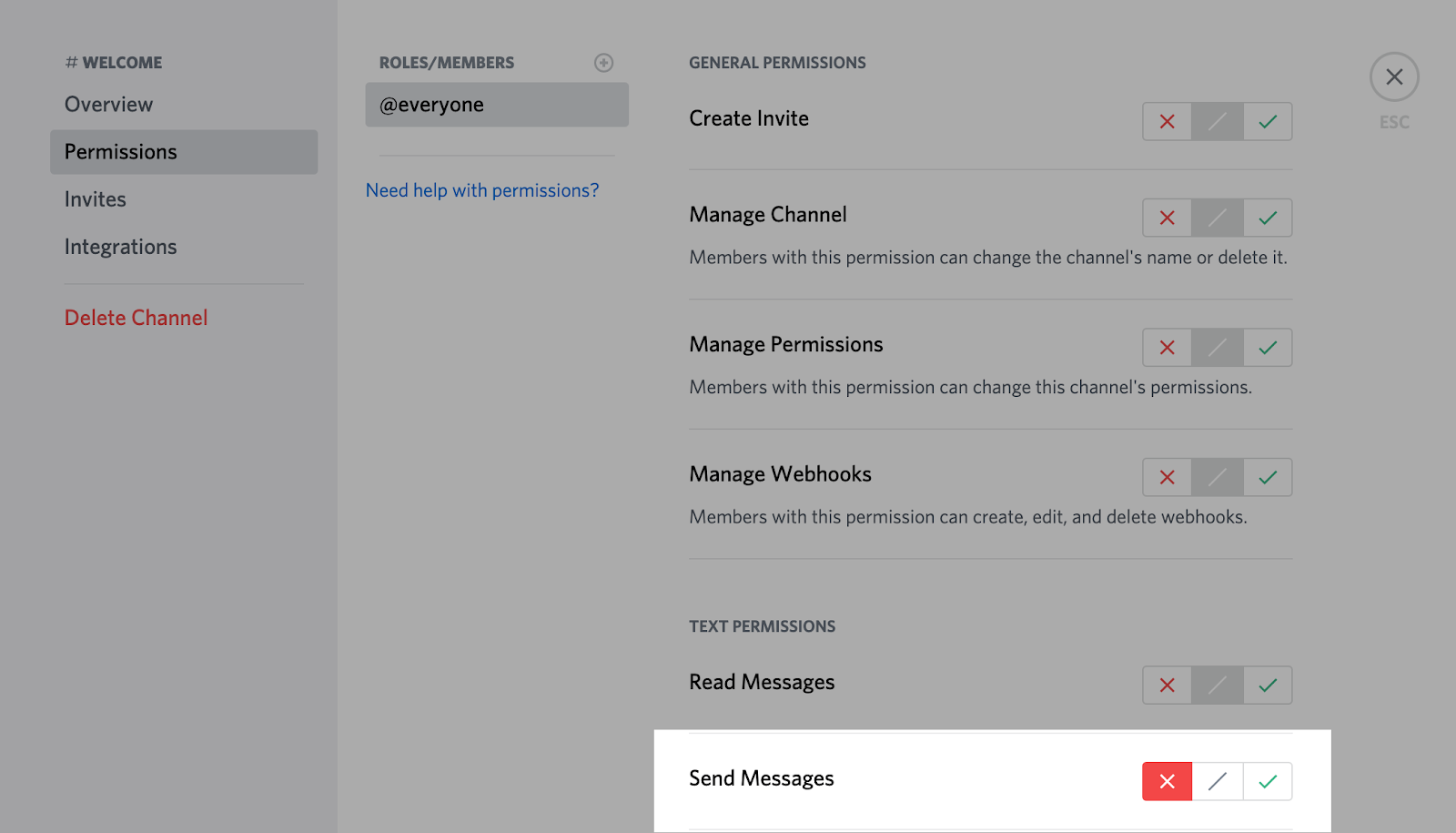
We can check that this has worked using the “View as Role” feature.
Head over to your roles page in the server settings and find the @everyone role, select “View Server As Role.”
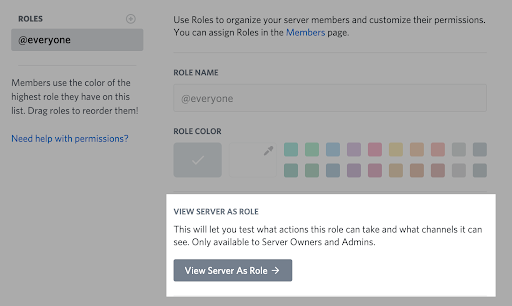
You’ll now notice that the message box has been disabled like we specified.

This is the #welcome channel all set up, we’re ready to move on!
Creating Region Roles
Next up, we need to create some roles to identify users from each region in the server. Head to the roles section of your server settings.
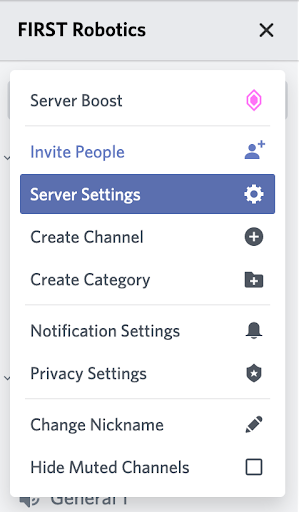
These roles don’t need to have any permissions for the whole server (like a role for Moderators would), since they are only used to gate access to the region categories.
You can optionally assign these roles a color to allow members in specific roles to stand out in channels, or hoist them in the member list to make it easy to find users in a group (for example, it’s useful to hoist Moderators so people know who to get in touch with). We’ll create two roles for the United States and Canada.
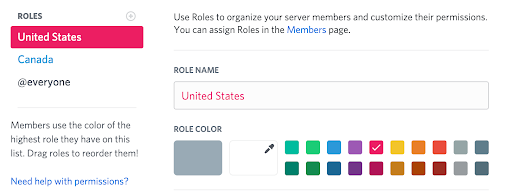
Make sure to save your changes at the bottom of the roles screen, and that’s all we need for the role setup!
Creating our region locked areas
Discord provides you with a way to group related channels together into Categories.
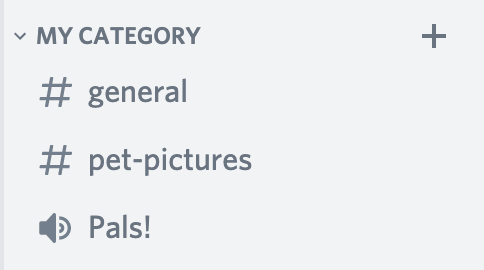
We’ll be creating a category for each region and channels within that. A great benefit of categories is that you can sync the permissions of the category to all channels within it, so you don’t need to set up permissions for any other channels in the same category.
Start by opening up the server menu and clicking the Create Category option.
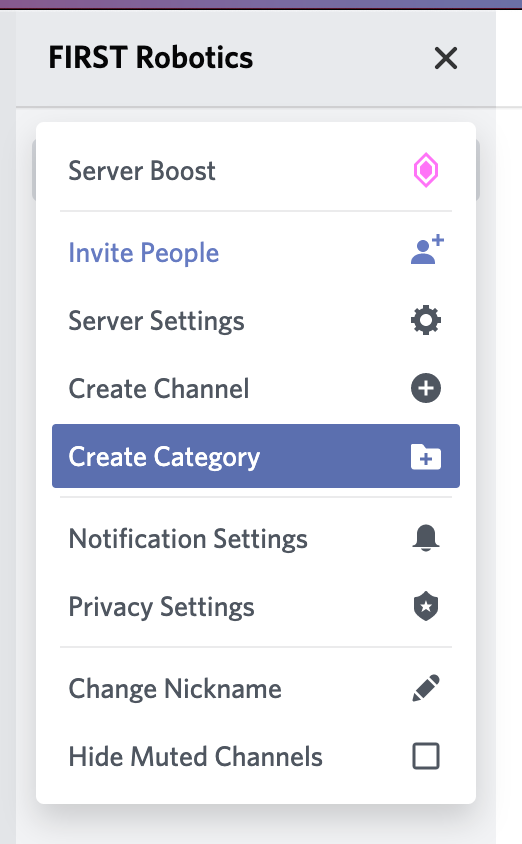
We’ll be making two categories in this example, one for each region role. We’ll start out with the United States category, which we’ll associate with the United States role.
You can automatically set up the permissions for a category so that only a certain role can access it. To do this, enable the “Private Category” option. Once you turn this switch on you’ll see a list of roles which you can enable to grant access to the category.
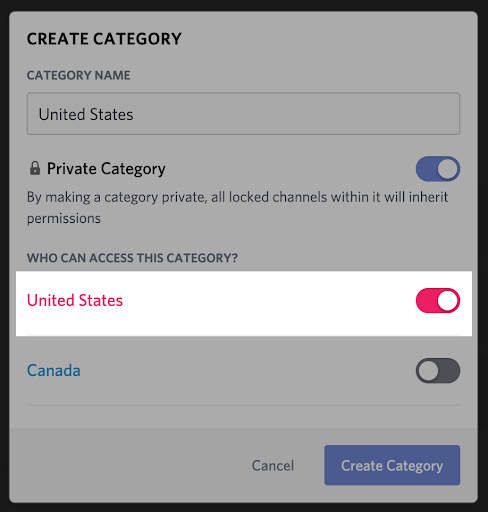
Find the role that you want to create the category for and flip the switch to activate it. Once that is done, hit “Create Category”. It will pop up in your channel list.

If you head into the permissions section for the category you will see which permissions the private category option has changed.
.png)

As you can see, the United States role has permission to read all text channels and voice channels, while the @everyone role does not have that permission.
However, what’s a category even for if there are no channels to populate them? Next, let’s make some channels for our newly made category- starting with a text channel and a voice channel. Click the + icon next to the category name to do this.

You do not need to select the private channel option while creating channels inside a category; by default the permissions of the parent category will also apply to the channels within it.

Once you’ve set up the channels within the category, open up the settings of one and take a look at the permissions. As you’ll see at the top of the permissions list, the channel is synced to the United States category. This means that if you update the permissions inside the “United States” category, the permissions in all channels within it will update.
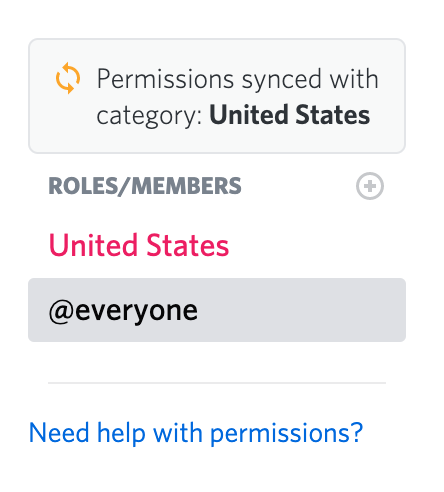
If you manually edit permissions of a channel within a category, it will go out of sync and you may need to tell Discord to re-sync that channel, in the process of which any specific changes to that channel will be lost. This is important to keep in mind since if you have any specific overrides in a channel and you sync it they will be gone, but also if you make any changes to the parent category they will not sync to the channel that you have manually altered, which is something to look out for.
That concludes the set up of the United States category- next we’ll repeat the same steps as above for the Canada channels by creating a category and setting the Private Category option to the Canada role.
After that, your channel list should look like the following.
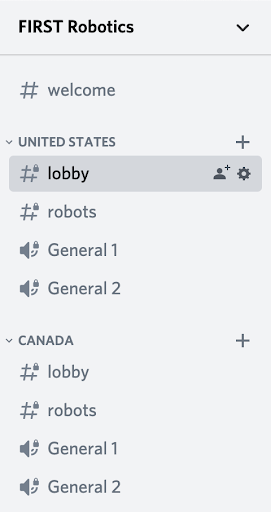
We can validate that the permissions work again by using the “View Server As Role” feature. This time instead of selecting @everyone, select one of the region roles.
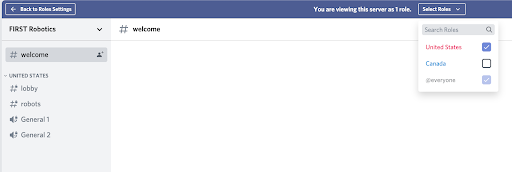
As you can see, while previewing with the “United States” role we can only see the United States category. You can change the selected roles to confirm that each of your region roles can see their respective category.
At this point you are ready to start inviting users! To invite a user, hit the invite button next to the welcome channel in the channel list.
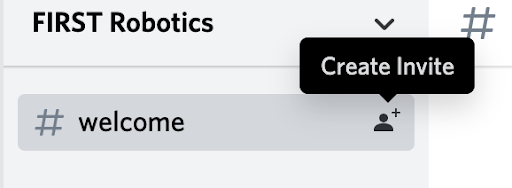
Make sure to select the checkbox to mark your invite as never expiring if you plan on posting it online. Otherwise, the invite will expire automatically and users coming across online posts will not be able to join.
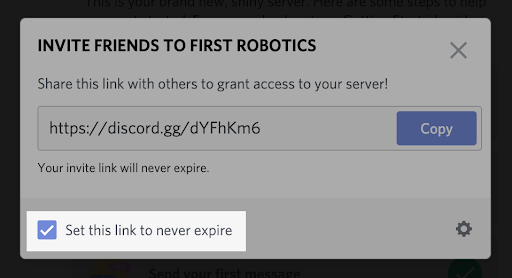
Once you have a link like this you are ready to share it!
Assigning region roles
When a user joins a server they will be presented with the welcome channel and information. They cannot see any other categories because they don’t have any region roles yet.
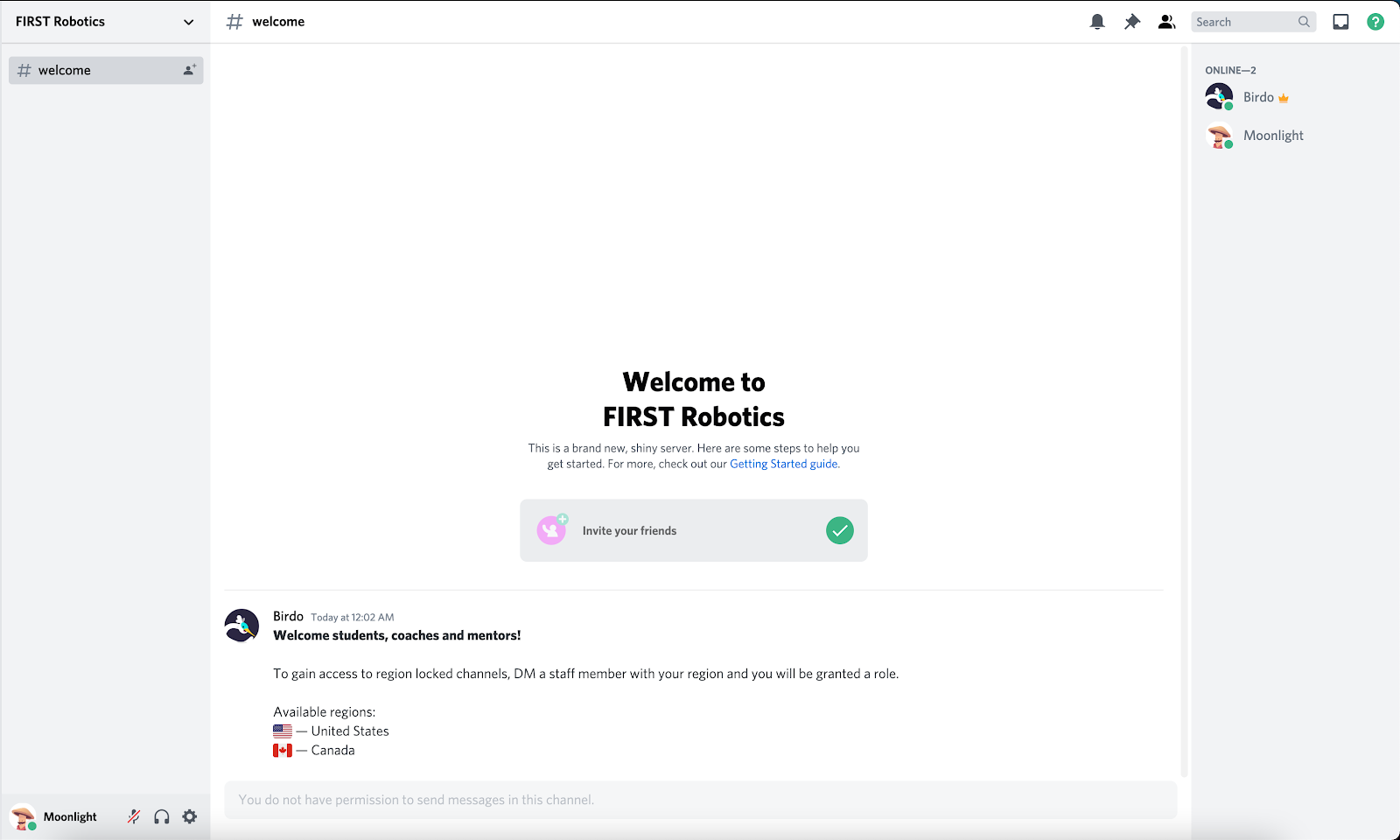
Users will get in touch via DMs to request region roles (we’ll mention alternative methods to automate this at the end!).

To grant the user access to the region channels, simply open the server’s member list in the server settings, search for their name and add the role!
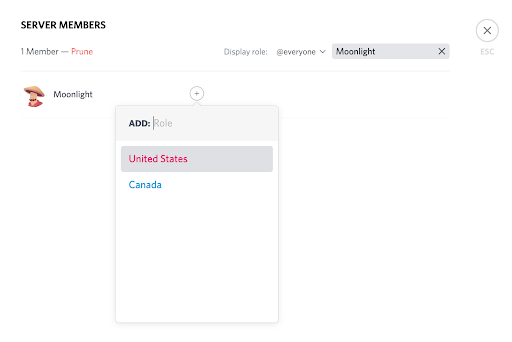
They’ll then immediately have access to the region category for the role you have assigned them:

Conclusion
This article has shown you how to set up a basic region locked server where you can grant access for specific users to specific categories. Discord’s “Private Categories” feature makes it simple to grant access to a category for a specific set of roles and set up the permissions for you.
With that in mind, here are some things to try with your new server:
- You can add more categories! You may want a Moderators category for other moderators to discuss in.
- You need to make sure Moderators can access all the categories and bypass the region lock if you want them to be able to properly moderate these spaces. Remember, adding permissions to the category will add it to all of the channels within - look at how the region role permissions have been set up and copy this for the moderators role!
- Having to manually assign roles is a laborious task which can be simplified with Discord bots. There are many reaction role bots available which allow users to add a reaction onto a message and be given a role for it. Try to find a reaction role bot that grants users access to your community by simply adding a reaction to your message.

Utilizing Role Colors
Role colors can serve a variety of purposes including but not limited to being a fun way to liven up your chat and make your server more colorful, acting as an integral part of your server currency system, or even as a tool to differentiate between different types of members in chat. While the average user may not be aware of the thought processes behind instituting server role colors, it is important to recognize role colors as a potentially important tool in your server depending upon how you choose to use them. Whether your role colors are for an aesthetic or to distinguish certain users, careful consideration needs to be put into the color scheme of your servers’ roles.
Types of Color Role Systems
Moderator Colors
Giving moderators a uniquely colored role can help them stand out in chat so that users are aware of when they are receiving an official verbal warning or direction. This can be very helpful in any server, but some structures that this system are most helpful in may include:
- Large, busy servers where individual messages do not really stand out in a faster moving chat
- Family friend spaces or servers targeted at younger users who may not oblige with requests from moderation and instead try to argue
- Smaller servers with a more horizontal leadership structure where it is likely that members will be self-moderating to a degree
- Reddit servers where you are trying to differentiate between Reddit moderation teams and Discord moderation teams
The words and actions of moderators hold more weight and urgency when geared towards problematic behavior and a colored role differentiation in addition to a hoisted position on the sidebar draws attention to their existence.
Having a separate color for moderators can also lead to some unfortunate social effects since moderators are not always moderating, but their unique role coloration exists to make them stand out in the server. This means if they’re just trying to converse with fellow users, eyes are more quickly drawn to their color for when they need to dispense advice. In heavily active servers, users may be more likely to see most of what a moderator posts since their messages stand out from everything else, but a moderator is unlikely to see most of what any individual user posts; this can lead to a parasocial relationship where users think that they know or are friends with the servers moderators. It can also lead to users paying undue attention to moderators when they are just around to chat, potentially ignoring other users, or drawing attention to the fact that a moderator has entered chat, effectively killing prior conversation topics. In certain servers, this can also be cause for concern if it is attracting the wrong kind of people to moderation based positions who are seeking hoisted roles or incorrect perceived perks of moderation positions. Overall, having a color for moderators is important in communities that are seeking to differentiate who is and isn’t a moderator in chat, but it can also lead to certain situations that may degrade a moderator’s ability to use the server normally as a member.
When utilizing such a role, It is important to keep an eye out for responses that do not treat moderators as respected members of the server and respond appropriately. Moderators are members first, and should be able to use the server in much the same way they did before becoming moderators, in addition to carrying out their moderation related duties.
Expert/Support Colors
If you are running any sort of support server, whether for a bot, a coding language, a game, or some other external service, it may be important to differentiate between regular users and developers or trusted experts. It will be a lot easier to tell if you are getting credible advice if there is a colored role that indicates that users with this color know what they are talking about. This type of system is useful for proficient users and developers. Such role usage can help prevent issues where misguided or confused users mistake a developer's explanation of their own code for incorrect advice.
An important thing to note about this system is that there are some pitfalls. It can inadvertently lead to a distrust of other users who do not have the proficient helper/developer support role color because they know they can get correct advice from a different source. They might dismiss others trying to help them with the knowledge that they can eventually get a developer’s attention, which can lead to a sense of entitlement to that direct advice. Of course, this can happen without role colors, but the addition of role colors make developer interaction more obvious and place them on a support pedestal that is often desired by those seeking advice.
Patreon/Booster Colors
Giving patrons, server boosters, or any other sort of member who has made financial contributions to the server a separate color from the rest of the server can be a good way to incentivize or reward the people who are helping keep your server, bot, service, or giveaways afloat. However, it can also contribute to a sense of elitism within the server. This inadvertent hierarchy can be misinterpreted as users being entitled to special treatment above the rules in exchange for their financial support of the server. Thankfully, both of these negative viewpoints are relatively easy to identify and combat, especially if you define what each of these kinds of roles get you clearly in your server rules so there is less assumption and personal interpretation of nonexistent hierarchical perks.
Level/Server Currency Colors
If your server has some sort of activity based leveling system, or a server currency system, it may be fun to include colored roles as rewards or shop items that can be purchased with the server currency. These systems can help you reward your most active members, and if your server currency has an attendance incentive it can even be used for event participation. It is important to note that these systems are abusable, and can contribute to low-effort contributions that are effectively just spamming for levels or points, or in extreme cases, even self-botting (automating actions on a non-bot, regular user account) and other forms of cheating. They can also contribute to toxic competitive environments and chats that can be unpleasant for users who do not care about the server levels or currency to try to break into. If utilizing such a system, it is important to think of ways to combat spam before implementation. Additionally, remember that self-bots are against Discord’s Terms of Service and should be reported and dealt with accordingly upon discovery.
Ideally, you want a level or server currency system to be something that is a fun background mechanic in the server, but not people's main reason for participating. These issues are not unique to colored roles, but anything that makes these systems more prominent and visible in chat will draw more attention to them. Level roles in particular can also contribute to the previously discussed accidental hierarchy built within the community by clearly establishing active long-term users from newer users. Climbing a level ladder can be intimidating, after all.
Informational Colors
Color roles can be used to signal information depending upon the type of community you run. Some examples include pronoun roles, what games a user plays, the age range they fit into, where they are from, and any other information your community may deem relevant for your users to know. This type of system is beneficial for sharing and collecting info about others. However, users may choose roles that they do not actually align with because they want the chat color associated with it, which is a detriment to more elaborate informational color systems. If you decide to utilize an informational color system it’s important to remember that Discord only shows the color that is highest on the role list and roles should be ordered with this in mind.
Seasonal/Self-Assignable Colors
The final type of role color discussed in this article is those decided by the server staff for aesthetic, but have no perks attached to them. Seasonally themed roles require a bit more work on the part of whoever is in charge of selecting the colors and naming the color roles, but can be a fun way to mark the passage of time, important events like winter holidays, or just change things up in the appearance of the server every once in a while with minimal effort.
Self-assignable colors have no downside other than increasing the number of roles your server has. They are a way to let users have a bit more control over their profile and how they appear to others, and change things up when they want to. Self-assignable colors are a fun and inclusive way to engage users, especially when part of a serverwide aesthetic.
Accessibility
When choosing role colors, you should keep accessibility in mind. A role color the same as the Discord background may seem like an entertaining color choice, but it can prove to be unreadable to many, for example. It is most important to remember that role colors need to be legible across all Discord themes including dark, light, and AMOLED themes. Many users may also have a form of color blindness, which should be considered when generating a color theme that is accessible for everyone.
It is important to ensure that role colors have sufficient contrast against the variety of background colors that Discord provides. There are many tools out there that can help you compare role colors, mimic the effects of various forms of color blindness, and see how much contrast they have so that you can see whether role colors will appear too similar or be difficult to read for some users. The Dragory Discord Preview Tool is specifically made for Discord and can easily be used to visualize everything you need to make sure you are choosing appropriate role colors all in one place.
Moderation colors should easily stand-out amongst server users to draw attention to them. If your server mostly uses cool colors, make them something warm. If you’re dominated by pastels, go for something with more saturation. Make it so that eyes are drawn to them if you use this system.
Conclusion
This article reviewed the many possible role color systems that you can utilize in your server by walking you through the benefits and drawbacks of each. These systems can also all be combined with each other in order to create a system that you believe serves your community best through experimentation. Luckily, the stakes for changing role color systems are pretty low. While role colors can have an impact on the way people interact with your server and with certain members, it will not make or break your server to try out a new seasonal theme and/or return to a previous theme if it is necessary. As long as you understand the risks associated with each kind of setup, keep an eye out for unwanted responses to your color scheme, and remember to utilize accessible colors, you can use whatever kind of system you want. There is no wrong answer here--just have fun with finding your server aesthetic!

Channel Categories and Names
The first thing people will see when they join your server is your channel list. Therefore, it’s important that your channels are clearly named and organized so that new users can easily find necessary information and readily understand how they should use each channel without being overwhelmed. To accomplish this, you should try to have organized channel categories where channels have clear names and topics, with pinned messages supplementing channel topics as needed.
Organizing Channels
When it comes to the initial order of your channel list, it makes the most sense to put the most important channels at the top to give users the background information they need about the server, followed by the channels you expect users to spend the most time in for easy access. Generally speaking, this means your rules channel and informational channels about the server as a whole such as the welcome channel or resources channel will be at the top of your list, followed by your main chat channels and then your more niche channels at the bottom.
Your top-most channel is specifically important because this is the channel that your Vanity URL will point to (if you have one). For this reason, this should generally be a welcome or rules-related channel. Also note that in order for your Vanity URL to work at all, you must have at least one channel on your server that is visible to @everyone with no other roles.
To further simplify your channel list, you can also use channel categories. Organizing channels into categories creates natural breaks in the channel list, allowing members to quickly read through it and find the channel they need. Members can also collapse categories as well, further allowing each user to hone in on channels that are important to them. Members of your server, especially new ones, may find it confusing to navigate a long, unbroken list of channels. Channel categories will further help them find the appropriate channel for any conversation they want to have or information they need to find.
However, it’s important not to put too many channels into one category, as this will create another long, unbroken list of channels that becomes difficult to navigate at a glance. Although there are reasons for including many channels in one category, keeping the amount to around four or five is ideal. You can also consider picking two or three of your most important channels and not placing them in categories at all, which will automatically bring them to the top of the channel list and prevent them from being collapsed into a category accidentally.
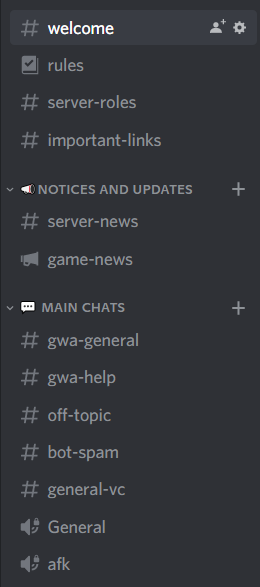
One more consideration for channel organization arises if you are utilizing variable channel lists. Simply put, this is any sort of system that allows people to change which channels they have access to. For example, if you implement a verification gate, you’ll need to consider what channels people should see before and after passing verification. You may also want to implement self-assignable roles through a Discord bot that allow people to opt in or opt out of viewing certain channel categories. Keeping the previous organizational tips in mind and using the View as Role tool will help you see what the server looks like before and after verification as well as with opt in or opt out channel roles and help you to organize them in a way that makes sense for your server.
Naming Channels
Once your channel list is easy to scroll through, the next step is making sure your channel and channel category names are easy to understand. Channel names can be as long as you want, but will be cut off after reaching approximately 25 characters, making them difficult to read. For example, the first channel below is just right, but the channel after is really extra super duper long and the full name isn’t displayed in the sidebar.

Channel names should ideally be unique in the server. Although nothing stops you from having multiple channels with the same name, creating identically named channels can make it easy to mention the wrong one in a message and confuse the reader. For example, if you have one category for On Topic channels and another category for Off Topic channels you could create a #on-topic-general and #off-topic-general respectively, rather than creating a #general channel in each category.
These are still kind of a mouthful, though. Another option could be to incorporate the topic of your server into these channel names. If your server is about Wumpus’s Grand Adventure, you could name your on-topic channel #wga-general and then simply name your off-topic general chat channel #off-topic.
Some people also like to add emojis to their channel names and categories. While this can be a good way to add some flair to your channel list, having too many emojis can detract from the names of the channels themselves. Furthermore, different devices render emojis differently, so what looks good on your own computer or phone may not look good on someone else’s device. Using emojis strategically to draw members’ eyes to important channels or using them only in category names instead of in every channel name may be better long-term. Similarly, you should also avoid using non-standard characters (e.g., 𝒻𝑜𝓃𝓉𝓈 ) when naming channels as this can make channel names difficult to read and mention.
There are many ways to go about it, but keeping your channel names concise, unique, and clear will go a long way towards making them easier for your members to read and understand their purpose at a glance. Some channels, however, may need additional explanation beyond simply their name and category.
Channel Topics and Pinned Messages
Channel topics and pinned messages are two ways to further explain the purpose of a channel, how to use it, and what channel-specific rules may apply.
Channel topics appear next to the channel name on the desktop and web Discord clients and on the members list sidebar on mobile. Long channel topics can be expanded by clicking or tapping on the topic text and support basic markdown formatting. However, if you want to mention another channel, role, or user in a channel topic, you’ll need to type out the raw form of the mention in order for it to show up in the topic properly. These raw forms are as follows:
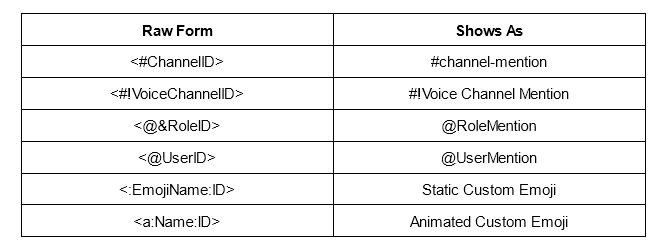
You can right click channels, roles, and users with Developer Mode enabled to copy the ID, and for emojis the ID will be the numbers at the end of the URL when you open the emoji in your browser. This will allow you to easily reference other entities as needed without needing to worry about the names of those channels, roles, or users changing in the future.
Although channel topics can be quite long, it’s important to remember that people will not want to read a wall of text about a channel. It is ideal for you to keep a topic down to one or two sentences long. However, depending on the purpose of the channel, explaining the proper usage and purpose can be difficult. If your channel topic starts to become paragraphs long or even hits the channel topic character limit, it may be better to simplify it and add “check the channel pins for more details” to the end. Pinned messages are more obscure than the channel topic when it comes to providing information about a channel, but have the advantage of giving you more space to explain the intricacies of the channel, use advanced formatting, and take advantage of link embeds and attachments.
Regardless of whether you use channel topics, channel pins, or both, including additional information about a channel beyond the category and name is an important part of ensuring everyone can understand the purpose of a channel and how it fits into the server.
Conclusion
Remember that your channel list is more than a series of chat rooms. Each one should serve a purpose in your community and it’s vital that you clearly communicate what channels are available and how people should use them. Organizing them into clear categories, using easy to understand names, and including information in channel topics and/or pins are all ways to achieve this effective form of communication with your members. The quicker members understand your channels, the faster they can start participating in your community and the more likely they’ll be to stick around. Although every server’s situation is unique, these basic methods will serve as a good foundation to make your channels easy to understand and use for all of your members.

Getting Started as a Server Admin & Running Your Server
Welcome, admins! That’s what we call anyone who runs a Discord server—and in no time at all, that can be you.
If you’re taking your first steps towards building a healthy community on Discord, you’ve probably got questions. As a future server owner or admin, you get to determine the architecture, community guidelines, and, of course, the actual purpose of your new virtual community. This article will walk you through the first things you need to know about building and running your own server.
What is a Discord server?
A Discord server is a space where members of a community socialize and share with one another through text posts, voice chats, and video streams.
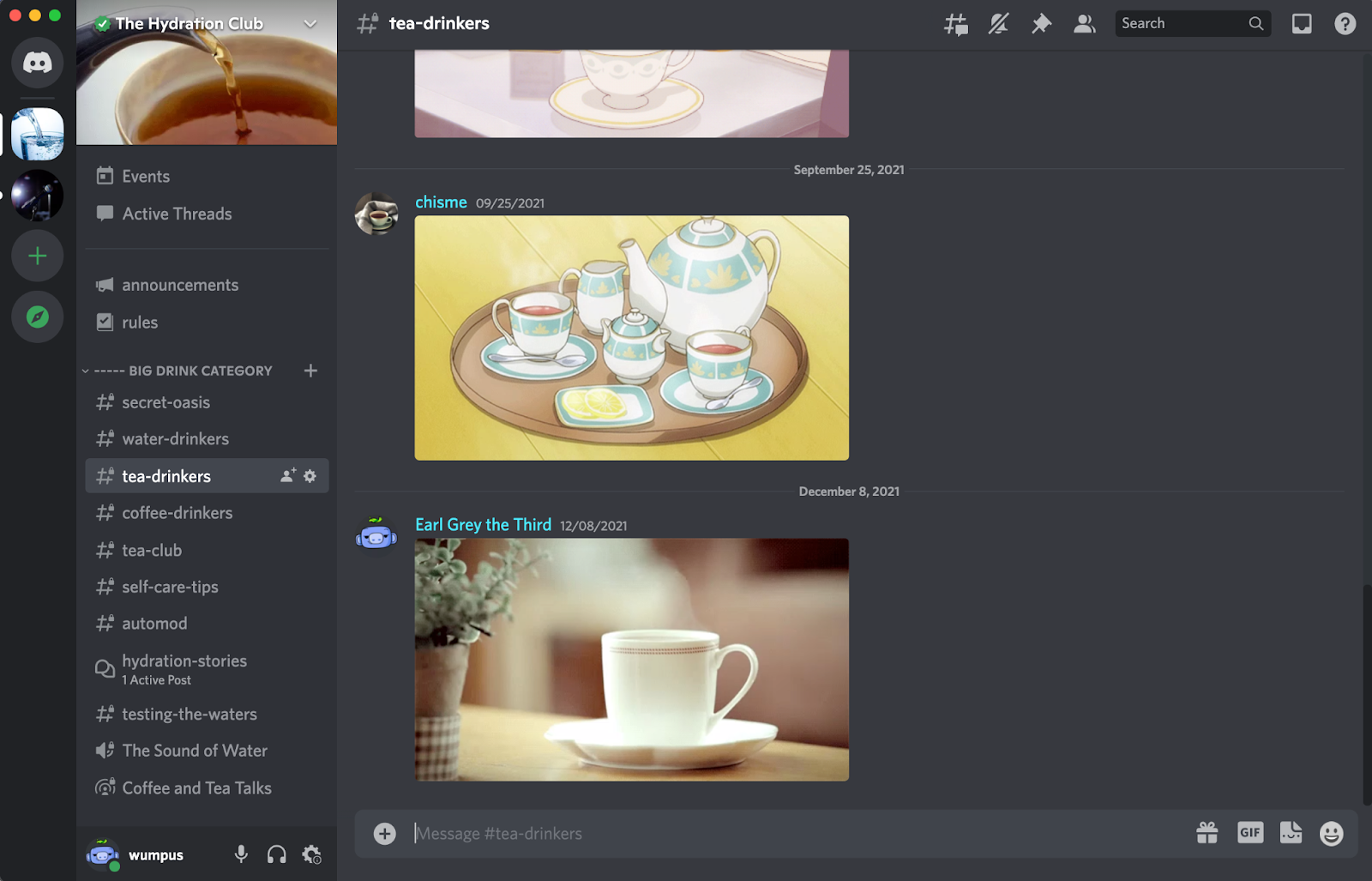
As the server’s creator you’ll have a lot of power to customize your space using your admin privileges. For starters, you can give some of that power to other members by creating roles that define what members can do, from sending and reading messages to inviting other people to your community, and even to helping out as a co-admin.
You’ll also create your server’s channels: individual spaces where text, voice, and video conversations actually take place!
Understanding and Creating Channels
If a server is a home where your community gathers, channels are the specific rooms in the house where they hang out for specific reasons. There are three types of channels on Discord:
- Text Channels - Members send written messages in an ongoing and real-time conversation stream. Text channels are also great for asynchronous conversations and allow users to share files, images, links, embedded media, stickers, and more!
- Voice Channels - Users have live audio-only or video conversations. Server members can also share their screen and stream content using our Go Live capability.
- Stage Channels - A channel for organized audio events, where select members can present to others (think of a handful of people live “on stage” while everyone else sits on mutein the “audience”).
Channels can be broad, multipurpose spaces – like a general chat where people discuss whatever’s on their mind — or more specific forums for users to connect on a specific topic (think a “basketball” text channel within a larger “sports” server).
It’s up to every admin to decide what kinds of channels best meet the needs of their community. Remember: if you want to build a community that sticks around, you want to build a server that offers unique value. You'll want to think: why should people come to my server and not any other?
Part of that will come through in the channels you create. A lot of servers have "food" text channels…but if your server has a whole category of channels for cooking, with text channels for sharing #recipes and discussing #restaurants and a voice channel for weekly #bake-alongs, fellow foodies will know they've found a community they can really sink their teeth into.
Once you’ve created a few channels, you may want to organize them into categories. This will help members find their way around your server by grouping similar channels in a single location.
You’ll customize your server’s channels in two menus: Server Settings and Server Dropdown. You can find both by left-clicking your server’s name in the top left corner.

Community Servers
If you’re planning on having more than a few people in your community, you should go into Server Settings and designate it as a Community Server. This will give you access to useful tools for running and growing your server. To name a few:
- AutoMod - An automated tool that can help protect your Discord server by blocking some undesirable and dangerous content before it’s posted.
- Server Insights - Data to help you understand how your server is growing and being used.
- Server Discovery - Turning this feature on makes sure your server shows up for people looking for new communities to join.
Sometimes, the hardest part is getting started. That’s why we created pre-made Server Templates to make building a community even easier. Use them right out of the box or treat them as a starting point: either way, your first server will be on its way to greatness.
- Local Communities Template
- Creators and Hobbies Template
- Global Communities Template
- Friends & Family Template
- Study Groups Template
- Design from Scratch
Once your server has been created - it’s time to invite your community! Want to explore all of the amazing features Discord has to offer? Check out our Beginner’s Guide to Discord to get started.

Setting Up Your Discord Server - How to Get Started
Getting Started
You’re part of an awesome global community of admins using Discord to make fun, safe, and purposeful spaces for anyone who wants to participate!
But before you start welcoming members and sending emojis, it’s important to get your server set up to make it easy for new members to join, navigate, and start contributing straight away.
Curating Your Channel List
Whether you're using a pre-set server template or starting from scratch, you’ll probably want to get started by curating your channel list.
The trick here is to keep things succinct and well organized. Too many channels or an overly complicated onboarding process can make your server feel intimidating and confusing, driving new members away.
Make Use of Channel Categories
Channel categories are a great way to organize your channels into easy-to-understand groups, like “Important,” “General Chat,” or “Memes.” This makes it easier for members to find the channels they're looking for and lets you sync channel permissions to entire categories.
Learn more about Discord permissions here.
Set Up Community Roles
In addition to moderator and admin roles, you’ll probably want to set up some community roles for fun and functionality. These might include EXP roles to recognize your most active members or letting members opt-in to specific roles (like getting announcements or specifying their interests or pronouns) using a self-assigning bot.
It’s also a good idea to take the time to properly set up roles with customized colors, icons, and assign each of them any relevant permissions.
And, if you really want to make sure everybody gets involved, an overview of each role’s functions, purposes, and how to obtain them in a #roles-explained channel is a great idea.
Time to Open the Doors to Your Community
Once you’re happy with the initial outline of your server, it’s time to enable Community.
As soon as you’ve done this, the Community wizards will ensure your server meets all the requirements and get you up and running.
Turning on Community gives you access to features that'll help you engage and grow your server, like Server Insights. You'll also gain access to critical moderation tools like AutoMod to help your hardworking moderators keep your community clean and safe.
Say Hey as Soon as People Arrive 👋
As soon as new members land in your server, the first thing they’ll see is your Welcome Screen.
It’s a good idea to use this space to include a description of your community and link some channels you want your new members to check out first.
When choosing these five channels, think about what new members might need to know first and where they can head to learn any key information. Ask yourself:
- How can new members gain full access to the server if you are using a verification gate?
- What do users need to know before beginning to participate?
- How can users start participating in the server?
Users who feel overwhelmed after joining your server are less likely to stick around, so having a clear and informative welcome screen is a great idea to make new members feel comfortable.
Top Tip: Members may want to refer back to this information once they’ve joined, so consider creating a #welcome channel to give any additional direction and share your community mission or purpose statement.
Screening New Members
The second onboarding tool you’ll gain access to is Membership Screening. This is an easy way to ensure your new members understand and agree to your community rules before they start participating in your server.
Additionally, if you want to manually screen members before they join, you’ll have the option to set up and review screening questions.
Top Tip: You’ll have a dedicated rules channel where you can dig deeper into more lengthy guidelines, so keep your screening section short and to the point.
TLDR: Keep Things Clear and Simple
In summary, keeping your server’s purpose clear and the structure of your server easy to navigate is key to retaining new members.
Even better, the easier it is for new members to understand your server and how to participate, the more likely they’ll be back to hang out day after day.
With thanks to NaviKing for all their help in writing this article.

Securing Your Discord Server & Creating a Safe Community
The Basics
Let's go over the variety of tools available to help you safeguard your server from malicious events or unwanted behavior.
You Are The Gatekeeper
Membership Requirements refer to anything that requires input from the user before they can join and is a great way to filter who gets involved in your server.
Your requirements can be as simple as having a user react to a message to prove they are human or something as in-depth as posting an introduction about why they want to join your server. Still, the key is to find something that helps filter out bots and spam accounts from joining your server.
Assigning Roles and Permissions
Assigning roles and permissions to your community is another great way to help keep your server safe and healthy.
- Server Roles: An overarching label that can be applied to a group of server members. For example: Moderators, Admins, General Members.
- Server Permissions: These permissions determine what people can do in your server. They’re split into Role, Channel, or Category permissions.
- Role Permissions: Permissions available for the whole server based on which role they have.
- Channel Permissions: Permissions available for a specific channel in a server and determine what members can do in that channel. Channel Permissions override Role Permissions.
- Category Permissions: Permissions available for a specific category in a server and affect all channels within this category. Category Permissions override Role Permissions.
Choosing the Right Roles and Permissions
When setting up roles for your admins and moderators, there are a few important things to keep in mind.
Think Carefully About Who Gets Permissions
Never give Admin or Kick Members permissions to anyone you don’t fully trust—including the bots. This permission should be reserved for you and people you know and trust.
Good Permissions to Give to Your Moderators
- Manage Channels
- Manage Roles
- Manage Messages
- Ban Members
- Delete Messages
Good Permissions to Give Your Members
- View Channels
- Create Invite
- Send Messages
- Read Message History
- Connect, Speak & Use Voice Activity
Make Use of “View Server as Role”
When you’re setting up server roles, use the “View server as role” feature (found in your server settings) to see what members with that role will be able to see.
Use the Role Hierarchy
Quickly restructure your community by dragging roles higher or lower than others in your roles list.
Beefing Up Your Server Security
Here are a few Top Tips every admin should know from Discord.
- User Flows: Set up verification requirements or enable Membership Screening to enforce guidelines and filter users as they join your server.
- Set Verification: Choose a verification level via Server Settings. You’ll see 5 different level options that all make members verify their accounts before they can engage in your server.
- Bring in AutoMod: Enable AutoMod in your server with Community on. Choose from readily available word filters or customize your own and select the responses AutoMod will take when users try sending messages containing those words in your server.
- Report a Raid: Discord reviews user reports of raids to develop tools that help servers prevent similar malicious activity. If you suspect your community has been targeted, you can provide data and help long-term moderation efforts by going to the Server Dropdown and selecting Report a Raid.
- Pause Invites: If you want to temporarily prevent people from joining your server without revoking your invite links, you can simply pause invites. Because it cuts off the flow of new arrivals, this can be an effective way to halt a raid in progress. It will also let well-intentioned community members trying to join know that the stoppage is temporary, and that soon, they’ll be able to come back to the same link and try again.
- Set Precautions: Set up 2FA for yourself and your admins and moderators to help protect you from bad actors taking over and tampering with your server.
Creating a Safe Space for Your Community
Keeping your server safe and secure will help you provide a better experience for all your community members and help to maintain a healthy environment for everyone.
Sure, you want your server to be welcoming and accessible, but it’s equally important to make sure it’s filled with the right people from the start.
Membership Requirements will also build your members' trust, giving them the confidence that this is a safe space full of like-minded people.
And remember: should a user break one of Discord’s rules, or for anything related to general safety, you can always submit a ticket to Discord.
(P.S. Our Moderator Academy has a load of great information on moderation and safety. Check it out!)
With thanks to Wunder#0001 for all their help in writing this article.

Making a Great Server & Building a Home for Your Community
Welcome Home
Discord is home to many servers, each of them unique. And yours is no different.
Your community and members will all have individual needs, so we’ve put together some top tips on making sure you build and organize your server to suit your mission and make it a welcoming, fun, and safe space for your members.
Choosing Your Channels
One of the best ways to build a successful server is to make sure that your group conversations and topics into separate, easy-to-find channels.
Why is this so useful? Because it stops new members from landing in your server and getting overwhelmed by a hundred busy channels. At the same time, it stops your server from becoming a single channel with six different topics all being talked about at once.
To keep things accessible and easy, it’s a good idea to set up a few key channel categories and organize your core channels into things like announcements and FAQs. This will help new members easily navigate your server and onboard into your community.
Categorizing Your Channels
A good rule of thumb for organizing your channels is: keep the important channels at the top, have your main chat channels in the middle and then have your least important, off-topic ones towards the bottom. We’ve found that four to five channels per category work best!
Here’s a good example of a basic setup!
Category: WELCOME
- Rules or Guidelines
- Role or Server Directory
- Announcements
- Introductions
Category: GENERAL
- General Chat
- On-Topic Channels
Category: OFF-TOPIC
- Off-Topic Channels for Other Interests
- Spaces for Members to Play or Interact
- Chats for Memes or Community Artwork
- Bot Commands
Channel overload? If you find yourself with many channels you absolutely need, you may want to introduce role-locked channels. These channels make sure that only people with certain roles have access, keeping relevant information accessible to the right people!
Naming Your Channels
Alongside keeping things organized, your channel names are a great way to show off your server’s personality.
For example, you might want to name your #general channel #cantina if you’re a sci-fi community. Or a #Ennorath if you’re a fantasy community!
You can also use non-standard characters (like emojis) to customize your channel names and make them look pretty, but don’t forget channel names will be cut off at the 25-character mark.
Top Tip: Empty channels can be daunting for new members, so use channel topics to explain the channel and kick off the conversation with a first message to get the chat going.
Customizing Your Server
On top of choosing your server icon and name, there are many other ways you can customize your server. This way, your members feel like they’ve stepped into a world made just for them!
Designating Roles
Roles aren’t just about functionality; they also impact how your server feels and can help you add touches of character and personality.
Sure, roles will allow managers to distinguish members from each other with features like role icons, colors, and permissions, but they’ll also help your users get more involved with your theme.
We love it when servers tailor their role colors and names, so they match the server theme or are references to an inside joke their community has. You may also want to give your Nitro Boosters a unique role for them to stick out or reward them as top fans!
Setting Up Emoji and Stickers
Emoji and stickers are another great way for your members to express themselves and convey your community message in and out of your server.
While Discord has a lot of its own emoji as well as 300 stickers, you can add your own unique emoji that match your server’s subject or theme. You can also involve your community to come up with suggestions or design their own. Your Nitro users will be able to use these in their other servers too!
Perks for Boosted servers
If your server is Boosted, you’ll have access to some additional customizable perks like...
- Customize your Server Banner: The image displayed at the top of the channel list is the Server Banner Background. Customizing this makes your community feel unique and helps users identify which server they’re visiting at a glance.
- Invite Splash: You’ll also be able to customize the image that appears when using an invite link in a web browser. This could be the first impression new members get, so try picking something that represents your community.
- Vanity URL: A Vanity URL is the server invite link unique to your community.
As your community grows and becomes more established, it’s important to do little things – like creating roles or having some fun with your server names – that make your members feel like, “yeah, this is the place for me” every time they return.
With thanks to east for all their help in writing this article.

Community Onboarding: Welcoming New Members
The key to keeping your servers healthy and thriving is to ensure new members are having a welcoming experience that isn’t overwhelming, especially for those that are new to Discord. The larger the server, the more important it is for new members to find what they are looking for, and Community Onboarding can help with that!
Giving members the ability to focus on important channels will make it easier for them to engage and find value from your server! Let’s walk through how to set this personalized experience for your new members.

Step 1: Pick Default Channels
First, you’ll pick a set of Default Channels that every new member will get on their channel list. It’s recommended to think about what channels are relevant to or enjoyed by new and existing members, and select those as Default Channels.
To find what channels would be best, you can check out your Server Insights to see which channels your community is reading and talking in the most. Don’t hesitate to just ask your community either, especially new members! Channels like #polls, #giveaways, #general, and more are all great default channels.

Step 2: Create Customization Questions
Next, you’ll build on your Default Channels by creating Customization Questions that let members pick additional channels and their roles. This is a great way to help new members create a more customized experience in your server, so you can help them find the stuff that interests them.
Here you can create questions with multi-choice answers. . Member’s answers will then add specific channels to their channel list and grant roles in an easily understandable way, even for new to Discord members!
It’s recommended you start with questions that assign all of your non-Default Channels to members. Here’s some example questions you can use:

A few best practices to keep in mind when creating these questions:
Keep it Simple! - Try to make the questions you’re asking understandable. Keep in mind that new members may not have all of the context and knowledge about your community. Encouraging them to get involved comes with them feeling comfortable knowing what they’re getting into!
Make it for them! - Remember that this is a tool for new community members. You, and the other admins, are going to gravitate towards specific channels; however, that doesn’t mean new members are going to want the same experience. We suggest checking in regularly with your community to see if these questions are helpful to send members to the right places.
Make the decision mean something! - Think about the gamut of channels your server has, and how those channels differ. When creating these questions consider asking yourself “If someone selects this answer compared to that answer, how is their experience different? And does the question I ask make it clear the answer will deliver that experience?”
Step 3: Make sure your member channels are assignable through Onboarding
Now that you have Default Channels and your Customization Questions, it’s time to double check that most of your channels are included in onboarding.
If channels aren’t part of either Default Channels or Questions, newer members may have a harder time trying to find those channels! If you have lots of channels left out, try creating questions or answers that assign them. You’ll have channels that add value in their unique ways, so make sure they’re accessible!
To help identify which of your channels are not assigned the feature will point out those channels in the Channels Not Assigned section.

To learn more about Community Onboarding check out our FAQ!

Essential Channels Every Community Server Should Have
Channels Every Community Server Should Have
Creating a server from scratch can be daunting—especially when you look into the empty space where all your channels will go. But while you’re settling on the topics and spaces that make your community unique, you can get your server off on the right foot with these common, useful, time-tested channels.
Housekeeping Channels
There’s a reason these three channels can be found in virtually every successful server: they help communities feel safe and welcome.
- #rules: State your server’s rules clearly and concisely, then set them as a welcome page by going to Server Settings > Community Overview. Servers have also found it helpful to allow only moderators the ability to post in a Rules channel.
- #introductions: By giving newcomers a place to say hello, meet existing members, and maybe even answer fun icebreakers, you’ll ensure your server gives off a good first impression.
- #suggestions: Giving your community a place to share their perspective on the server will ensure they feel valued and engaged.
Fun Channels
These common channels are often crowd-pleasers.
- #pet-pictures: Pet owners rarely pass up a chance to show off their furry friends…and who doesn’t like looking at cute animals?
- #off-topic: Creating a place just for side chats and casual conversation helps the rest of your server keep focused.
- #self-promotion: Showcase your server’s creativity by giving members spaces to show off their work.
- #games (i.e. #wordle, #ffxiv): When members have a place to post their victories and vent their defeats, daily games become a great community bonding activity.
Support Channels
Depending on your community, some of these less-common channels could offer your members a useful service. Consider giving these a read and thinking about which might come in handy.
- #quick-questions: A place for members to ask you and your moderators simple questions without getting buried in #general.
- #vent: Dedicated “vent” channels give community members a chance to share their troubles without bringing down the mood. Just take care to ensure this environment remains safe and supportive.
- #going-live: A place to let your community know when the next stage event or stream is happening allows members to plan their attendance.
- #highlights: Give people who missed the live events a chance to see what they’re missing. You may want to make this channel moderators-only to ensure you put your best foot forward with each clip.
- #looking-for-group: Help your users find groups to play their games with—because the server that plays together, stays together.
Looking through your favorite servers might help you spot other channels your community might enjoy.
Above all else, consider both the conversations your members will want to have and the ones you’ll want to encourage. Choosing your channels carefully is a good way to ensure a successful and engaged community.

Customizing & Branding Your Discord Server
Picking Your Channels
When you’re building your server, remember to always create channels thoughtfully. If you create one for every topic, engagement will drop off and your community will feel you’re not paying attention to what they care about. As much as possible, you want every channel to address a need that your specific, unique community has.
You don’t always have to guess what those needs are. Once you’ve gotten started with a few simple channels, it might be better to look for common themes in the conversation before adding more. If people love talking about video games in #general, for example, consider adding a #videogames channel. If you notice diehard JRPG fans taking over #videogames all the time, you might want to add #jrpgs. We like to call channels like these “breakout channels.”
While there are channels you’ll probably always want to include, even these can be customized to suit your community. For example, just because you’ve got a general chat doesn’t mean you have to call it #general: a fantasy-themed server might call it the #tavern, a server for your city might have the #town-square, and a serious philosophy server might offer both #general-discussion and #just-chatting. All communicate the vibe of the server well while offering the same basic functions.
Similarly, you’ll want to make sure that any channels you have for making new members feel at home—#welcome for telling people what your server’s about, #introductions for saying hi, #FAQ for answering questions people often ask, and so on—give off the appropriate tone for your community. Putting jokes in your FAQ is a great way to let people know your server’s all about relaxing and having a good time. Putting in a glossary, on the other hand, is a good way to let people know it’s about deep-dives on niche subjects.
Customizing Your Server Profile
There are a lot of ways to make your server look and feel unique with custom assets. For example, be mindful when creating the following:
- Server Icon - Because your icon is the “face” of your server, you’ll want one that resonates with your community. You may even want to hold a contest, commission it, or otherwise source it from them!
- Custom emoji and stickers - Great for honoring in-jokes, commemorating great moments, or assisting conversations (for example, chess pieces for your board game server). As a bonus, Nitro members will be able to use these in other servers.
- Boosted assets - Servers that have been boosted by Nitro members can set custom banner images, invite splashes, and vanity urls.
- Header images - Especially in locked or pinned channels like #rules, using images as header for your channels is a great way to achieve a polished and customized look.
Roles
Roles fill a number of diverse functions in your server. Depending on what your community’s about, here are a few ways you can design them to achieve the right vibe and functionality.
- Top Fans - You might want to honor the most active, long-term, or accomplished members of your community with special roles. These might be general (“Superfan”) or specific to the person (“Grilled Cheese Expert”).
- Channel Access - You can hide channels from or reveal channels to a member based on their roles. Want to make a secret clubhouse for subscribers? A spot for moderators to plan the monthly surprise event? A discussion channel for sensitive topics not everyone wants to participate in? Roles can be a useful way to expand your server’s functionality.
- Interests and Demographic - Roles can help express what your community’s about, as well as who members are. If your server has roles to indicate members play certain video games, it tells new members that those games are popular in your community. If your server has roles for different languages, it tells international members they’re welcome.

The Discord App Directory
Discord apps serve a vital role on the platform. They can help moderators by automating tasks, create delightful experiences for members with stats and mini-games, and layer in whole new levels of functionality for communities. But finding apps on third-party websites and developer channels hasn’t always been easy. That’s why we’re stepping up to provide a seamless, on-platform source for admins to browse, discover, and add apps to their communities: The App Directory.

Finding New Apps
There are hundreds of options on the App Directory. While it’s fun to wade through them all, you might find it helpful to start with specific categories that speak to what you’re looking for.
Looking to give your users some fun new options? Try checking out Games, Social, or Entertainment. Want to lighten your load as an admin or structure your server more efficiently? Try looking at Moderation and Tools, or perhaps Utilities.
It’s also worth checking in with our Collections every now and again. These are apps we’re currently choosing to highlight, which may include hidden gems, fan favorites, and rising stars, that offer something for a wide range of servers. You can check back in to the App Directory over time to see different apps in Collections.
A Closer Look at Apps
Each app in the Directory has its own page. There you’ll find useful info, like what categories the app belongs to, where you can find the developer’s website and social accounts, popular slash commands, and so on. There may even be an invite to a Discord server where you can try out the app or receive support.
You may notice that a few apps offer subscriptions to Premium Features that you can purchase through Discord, bringing you all-new levels of customization and functionality in exchange for your patronage. We love seeing hard-working developers get the support they need, so if you see something interesting, give it a try! Premium App subscriptions are rolling out slowly, so keep your eyes peeled for more ways to support your friendly neighborhood developer.
Somewhere on the App Directory is the next interesting, useful, and creative addition to your favorite Discord community. Take a look! You never know what you’ll find out there.













